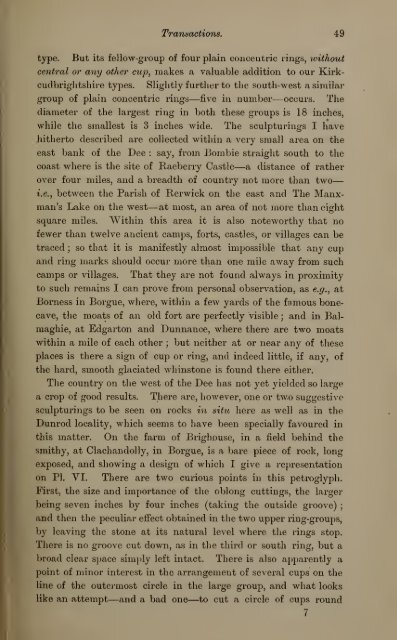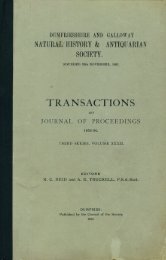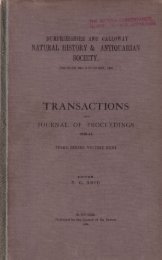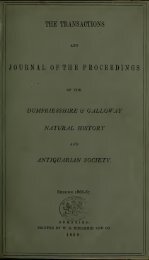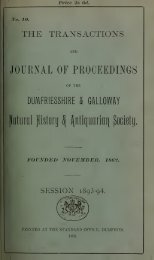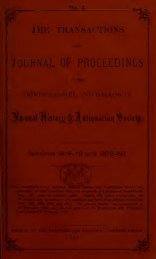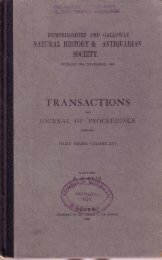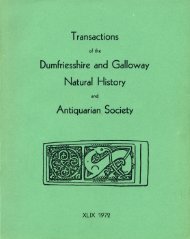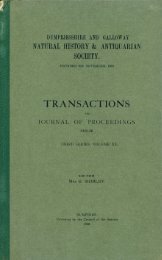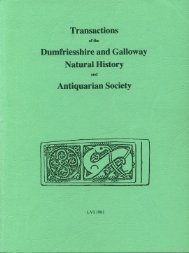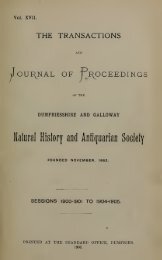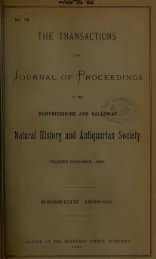Vol 5 - Dumfriesshire & Galloway Natural History and Antiquarian ...
Vol 5 - Dumfriesshire & Galloway Natural History and Antiquarian ...
Vol 5 - Dumfriesshire & Galloway Natural History and Antiquarian ...
Create successful ePaper yourself
Turn your PDF publications into a flip-book with our unique Google optimized e-Paper software.
—Trannactions. 49type.But its fellow-group of four plain concentric rings, ivithoutcentral or any other cup, makes a valuable additionto our Kirkcudbriglitshiretypes.Slightly further to the south-west a similargroup of plain concentric rings—five in number— occurs. Thediameter of the largest ring in both these groups is 18 inches,while the smallest is 3 inches wide. The sculpturings I havehitherto described are collected witiiin a very small area on theeast bank of the Dee : say, fi'om Bombie straight south to thecoast where is the site of Raeberry Castle—a distance of ratherover four miles, <strong>and</strong> a breadth of country not more than twoi.e., between the Parish of Berwick on the east <strong>and</strong> The Manxman'sLake on the west— at most, an area of not more than eightsquare miles. Within this area it is also noteworthy that nofewer than twelve ancient camjjs, forts, castles, or villages can betraced ; so that it is manifestly almost impossible that any cup<strong>and</strong> ring marks should occur more than one mile away from suchcamps or villages.That they are not found always in proximityto such remains I can prove from personal observation, as e.g., atBorness in Borgue, where, within a few yards of the famous bonecave,the moats of an old fort are perfectly visible ; <strong>and</strong> in Balmaghie,at Edgarton <strong>and</strong> Dunnance, where there are two moatswithin a mile of each other ; but neither at or near any of tlieseplaces is there a sign of cup or ring, <strong>and</strong> indeed little, if any, ofthe hard, smooth glaciated whinstone is found there either.The country on the west of the Dee has not yet yielded so largea crop of good results.There are, however, one or two suggestivesculpturings to be seen on rocks in situ here as well as in theDunrod locality, which seems to have been specially favoured inthis matter. On the farm of Brighouse, in a field behind thesmithy, at Clach<strong>and</strong>olly, in Borgue, is a bare piece of rock, longexposed, <strong>and</strong> showing a design of which I give a representationon PI. VI. There are two curious points in this petroglyph.First, the size <strong>and</strong> importance of the oblong cuttings, the largerbeing seven inches by four inches (taking the outside groove) ;<strong>and</strong> then the peculiar effect obtained in the two upper ring-groups,by leaving the stone at its natural level where the rings stop.There is no groove cut down, as in the third or south ring, but abroad clear space simply left intact. There is also apparently apoint of minor interest in the arrangement of several cups on theline of the outei-most circle in the large group, <strong>and</strong> what lookslike an attempt—<strong>and</strong> a bad one—to cut a circle of cups round7


